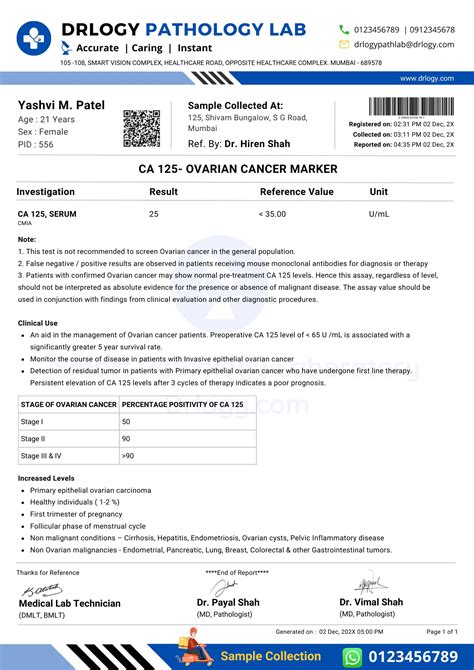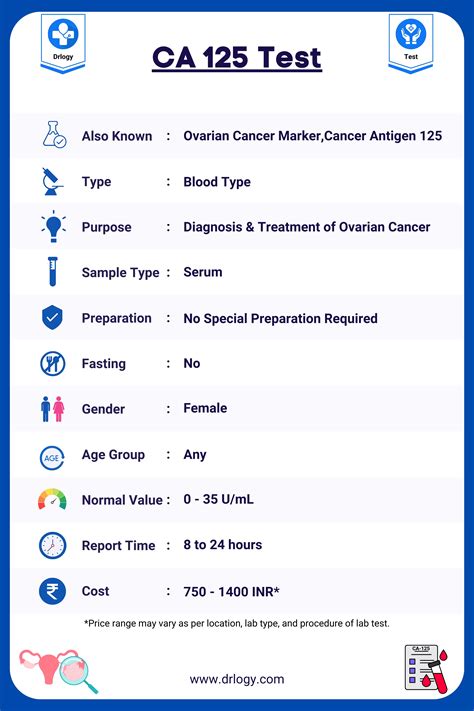Intro
Discover 5 key facts about CA 125 blood work, a vital ovarian cancer screening test, including its purpose, procedure, and implications for womens health, tumor markers, and diagnostic accuracy.
The importance of regular health check-ups cannot be overstated, especially for individuals with a family history of certain diseases. One crucial test that has gained significant attention in recent years is the CA 125 blood test. This test is primarily used to monitor and detect ovarian cancer, but its applications extend beyond this specific use case. Understanding the implications and results of the CA 125 blood test can empower individuals to take proactive steps towards their health. In this article, we will delve into the specifics of the CA 125 blood test, exploring its purpose, interpretation, and the factors that can influence its results.
For many, the term "CA 125" might seem mysterious, but it refers to a protein that can be found in the blood. This protein is often elevated in individuals with ovarian cancer, which is why the CA 125 blood test is a valuable tool in the early detection and monitoring of this disease. However, it's essential to understand that an elevated CA 125 level does not necessarily indicate cancer. Various benign conditions can also cause an increase in this protein, emphasizing the need for comprehensive medical evaluation when interpreting test results.
The significance of the CA 125 blood test extends beyond its role in cancer detection. It highlights the broader importance of preventive care and the need for individuals to be proactive about their health. By understanding more about this test and what its results might mean, individuals can better navigate the healthcare system and make informed decisions about their well-being. Whether you're undergoing this test as part of a routine check-up or because of specific health concerns, being informed can reduce anxiety and empower you to take control of your health journey.
Introduction to CA 125 Blood Work

How CA 125 Blood Work is Used

Benefits and Limitations
The CA 125 blood test has several benefits, including its non-invasive nature and the ability to monitor disease progression or response to treatment over time. However, it also has limitations. The test is not specific for ovarian cancer, meaning that elevated levels can be caused by other conditions such as endometriosis, uterine fibroids, and even pregnancy. This lack of specificity can lead to false positives, causing unnecessary anxiety and additional medical interventions.Interpreting CA 125 Blood Test Results

Factors Influencing Test Results
Several factors can influence CA 125 levels, including but not limited to: - **Menstrual Cycle:** CA 125 levels can fluctuate during the menstrual cycle. - **Pregnancy:** Levels may be elevated during pregnancy. - **Other Medical Conditions:** Endometriosis, pelvic inflammatory disease, and liver disease can cause elevated CA 125 levels. - **Surgery:** Recent surgery, especially on the abdomen, can temporarily increase CA 125 levels.Preparing for the CA 125 Blood Test

What to Expect During the Test
The CA 125 blood test itself is a simple procedure that involves drawing a blood sample from a vein in the arm. The process is quick, usually taking only a few minutes, and while it may cause some temporary discomfort, it is generally well-tolerated. After the sample is collected, it is sent to a laboratory for analysis, and the results are typically available within a few days.After the Test: Next Steps

Emotional Support and Resources
Receiving a diagnosis of ovarian cancer or dealing with the uncertainty of an elevated CA 125 level can be emotionally challenging. It's crucial to remember that support is available. From counseling services to support groups, both online and in-person, there are numerous resources designed to help individuals and their families navigate this journey. Staying informed and connected with others who understand the challenges can make a significant difference in coping with the emotional aspects of a cancer diagnosis.Future Directions and Research

Advancements in Diagnostic Techniques
Advancements in diagnostic techniques, including improvements in imaging technologies and the development of new biomarkers, hold promise for enhancing the detection and management of ovarian cancer. These advancements could potentially lead to earlier detection, more effective treatment options, and improved outcomes for patients.Conclusion and Final Thoughts

As we look to the future, ongoing research and advancements in diagnostic technologies promise to enhance our ability to detect and treat ovarian cancer effectively. Until then, awareness, education, and proactive healthcare practices remain our best defenses against this disease. If you or someone you know is affected by ovarian cancer or has concerns about the CA 125 blood test, don't hesitate to reach out to healthcare professionals for guidance and support.
What is the primary use of the CA 125 blood test?
+The primary use of the CA 125 blood test is in the monitoring and follow-up of patients with ovarian cancer, as well as in assessing the response to treatment.
Can the CA 125 blood test detect ovarian cancer early?
+While the CA 125 blood test can be used as a screening tool for ovarian cancer, its effectiveness in detecting the disease early in asymptomatic women is still a subject of debate. It is more commonly used for monitoring patients with known ovarian cancer.
What can cause elevated CA 125 levels besides ovarian cancer?
+Elevated CA 125 levels can be caused by various conditions including endometriosis, uterine fibroids, pregnancy, pelvic inflammatory disease, and liver disease, among others.
We hope this comprehensive overview of the CA 125 blood test has provided you with valuable insights into its role in healthcare, particularly in the context of ovarian cancer. Remember, staying informed and proactive about your health is key to navigating the complexities of medical testing and diagnosis. If you have any questions or concerns, don't hesitate to share them with us or consult with a healthcare professional. Together, let's work towards a future where awareness and education empower us to take control of our health journeys.
